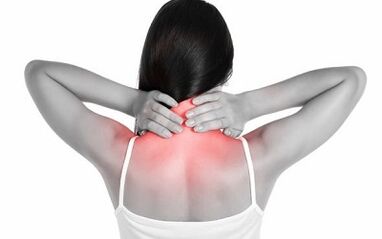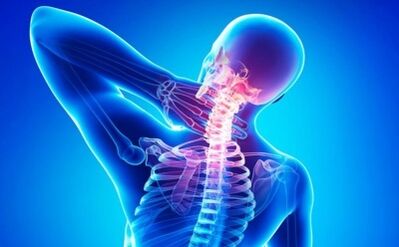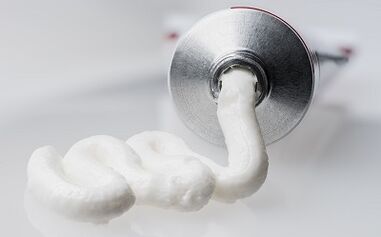The sedentary lifestyle, typical of most modern people, often leads to diseases of the musculoskeletal system. One of them is cervical osteochondrosis. Recently, the disease has become much younger and its symptoms are often found in people over the age of 25. If left untreated, the pathology can lead to dangerous consequences.
Causes of pathology

The main cause of cervical osteochondrosis is the incorrect distribution of the load on the spine. The factors that lead to this can be different. Let's say that a person is used to carrying a heavy bag on one shoulder, sleeping or sitting in the wrong position, etc. These factors seem to be insignificant, but when they act for a long time, they lead to a completely logical consequence - osteochondrosis. cervical spine.
The risk factors that increase the likelihood of pathology are as follows:
- Overweight;
- lack of physical activity;
- transfer of spinal injuries;
- posture disorders;
- foot pathology;
- deterioration of the blood supply to the cervical spine.
These causes lead to the formation of an incorrect position of the vertebrae. The weight is distributed unevenly to the vertebrae, due to which some parts of the cervical vertebrae withstand excessive stress. In response, tissue changes occur.
The following factors can also make the situation worse:
- transfer of a serious illness or injury leading to depletion of the body;
- constant stress;
- metabolic disorders in the body;
- insufficient use of microelements, their excessive consumption or insufficient absorption by the intestines;
- occupational diseases (especially vibration diseases);
- genetic predisposition to osteochondrosis;
- scoliosis and other posture disorders;
- non-compliance with the drinking regime;
- malnutrition;
- bad habits;
- pregnancy.
Most often SHOX provokes a complex of factors. Lifestyle, general health and the presence of background pathologies play a role in its occurrence.
Symptoms of the disease

Even in the initial stage, it can be recognized by the following symptoms:
- pain in the neck, back of the head, arms, shoulders;
- weakness of the upper limbs;
- headache and crunch;
- general weakness and fatigue;
- frequent dizziness;
- lack of coordination;
- numbness of the tongue, hearing and vision impairment.
The most common symptom is dizziness. It may be accompanied by:
- noise and tinnitus;
- migraine;
- nausea and vomiting.
Patients often suffer from headaches, especially women. Sometimes it occurs:
- anxiety;
- irritability;
- constant mood swings;
- sleep disorders.
How is a problem diagnosed in this part of the spine?
SHOX is diagnosed by the following methods:
- Radiography. This method is not always effective, especially in the later stages of the pathology.
- NMR. It makes it possible to see bone structures, hernias, their size and direction of development.
- CT. Computed tomography is less effective than magnetic resonance imaging because hernias and their size are difficult to determine with this method.
- Ultrasound duplex scanning. This method is used if there is a suspicion of impaired blood flow in the arteries. The scan makes it possible to assess the speed of blood flow and the presence of obstacles in front of it.
Features

The disease can occur in different ways. Sometimes it is compensated, sometimes exacerbations appear.
Along with the pathological process, compensatory mechanisms are activated, which prolong the functions of the vertebrae for some time and eliminate the symptoms. But with the further course of the disease leads to the destruction of the fibrous ring and the appearance of microcracks. The vertebrae lose fixation and stability.
Also, osteochondrosis is characterized by impregnation of the pulp of the space between the vertebrae with calcium. In view of this, a type of hernia is formed, as the affected vertebra is pressed into the human body next to it.
Over time, the structures wear out, leading to mass ossification.
Stages
The course of the disease is divided into several stages:
- Stage 1.Instability of the vertebral structures and disc disorders.
- Stage 2.Reduced fixation of the spinal areas, protrusion of the disc.
- Stage 3.Rupture of the fibrous ring, obvious symptoms and pain.
- Stage 4.Difficulty moving, severe sharp pain, widespread bone tissue.
Due to the peculiarities of the location of blood vessels and muscles, the neck is a vulnerable area. With a long course of osteochondrosis, many complications occur, many of which pose a serious threat to human health.
How to provide first aid at home?
Treatment of cervical osteochondrosis at home includes:
- medicines;
- physiotherapy;
- massage;
- therapeutic gymnastics;
- dietary adjustment.
In combination, the methods of therapy allow to achieve good results in the treatment of cervical osteochondrosis. The symptoms of the disease can cause serious discomfort, so you need to know how to give first aid.
Medicines
Various drugs are used to combat the symptoms of the disease. They should be prescribed by a doctor who specializes in the treatment of osteochondrosis - a neurologist or vertebrologist.
Medicines

- In severe pain you can take painkillers. If they do not work, NSAIDs can be taken.
- Sometimes "distractions" are used, such as pepper. In itself, it does not heal, but warms the inflamed area and relieves pain.
- Herbal infusions and diuretics are useful for swelling in the area of inflammation.
The following groups of drugs are prescribed to treat SHOC:
- Non-steroidal anti-inflammatory drugs. Help relieve pain, swelling and inflammation of the affected nerve root.
- B vitamins. They help to improve metabolic processes in nervous tissues.
- Chondroprotectors. Promotes the recovery of cartilage tissue.
- Muscle relaxants. Helps reduce muscle spasms.
- Drugs aimed at improving the rheological properties of blood flow and blood. They help to improve the process of blood flow to the brain and nutrition of the affected nerve endings.
Intramuscular injections may also be indicated.
Ointments

Osteochondrosis ointments help to eliminate the unpleasant symptoms in the initial stage of the pathology. They are classified according to the effect on the body:
- Anti-inflammatory.The preparations contain non-steroidal anti-inflammatory substances, which help to eliminate pain and improve the permeability of capillaries, reduce inflammation, swelling and redness.
- Warming.Such ointments have a number of contraindications, but in some cases they are very effective.
- Complex preparations.Agents from this group relieve pain and inflammation, have antithrombotic and antimicrobial effects. They immediately penetrate the tissues of the joints, normalizing blood flow.
- Plant-based products.The advantage of such ointments is the naturalness of the composition. But you have to use them for a long time.
- Chondroprotectors.Means of this type protect cartilage tissue from negative factors. Ointments include chondroitin, glucosamine. They activate the processes of tissue repair and reduce inflammation. It is recommended to use them 2-3 times a day, having previously massaged the neck area a bit.
Massage

Massage helps to strengthen muscle tone and relieve pain. His technique is chosen depending on the stage of the disease. But in most cases, all the techniques of classical massage are used: rubbing, stroking, kneading, etc.
- If the patient's pain appears on one side only, the massage starts from a healthy area, gradually moving to the place where the pain occurs.
- The first session should last no more than seven minutes. Then each procedure is increased by 1-2 minutes until the session time reaches 12 minutes.
- The patient should lie down, placing the forehead on the cysts and hands and stretching the chin to the chest. It is important that the neck muscles are relaxed.
Independently
The massage can be done at home, but in this case you must be very careful not to hurt yourself even more. Self-massage with SHOX includes the following classic techniques:
- Stroking.The massage begins by stroking the collar area in the direction from the lymph to the axillary and supraclavicular nodes. Then the flat and ridge types are ironed.
- Pushups.The arm is placed through the neck and moves down the spine. Push-ups can also be performed with the edge of the palm to the shoulder joints.
- Friction.It is performed to warm up and relax the muscles. The massage begins at the base of the skull. Straight and circular movements are made with the fingers. Cutting movements can also be performed with the palms parallel to the ribs.
- Kneading.The neck is stretched in circular motions.
- Vibration.The massage ends with shocks and vibrations performed by shaking and tapping.
Physiotherapy
Therapeutic gymnastics helps to improve the patient's condition. But it will be safest during the recovery period. The patient should not experience pain or discomfort during the performance. The exercises are aimed at strengthening the muscles of the neck.
Complex training therapy

The gymnastic complex must be chosen by a doctor. The following exercises are useful:
- In a supine position, you should rest your arms on the floor and slowly raise your head, keeping your back and torso straight. You should stay in the upper position for a few minutes, then smoothly return to the starting position. Do 2-3 repetitions.
- You need to lie on your stomach, stretch your arms over your body. The head turns first to the left, then to the right. Try to touch the floor with your ear. At least 6 repetitions are performed for each side.
- In a sitting position, when inhaling, you should bend down to touch your chest with your chin, then when exhaling, lean back, throw your head back. The number of repetitions is 10-15.
- You have to press your forehead with your palms and hold them with your forehead for 30 seconds. After the exercise is repeated with pressure on the back of the head with folded arms. The number of repetitions is 2-3.
- Smooth rotations of the head to the side are performed - 10 times each. Dizziness should be avoided during this exercise.
Additional therapy
The treatment can be supplemented with physiotherapeutic methods, as well as with the use of various devices, such as massagers.
Massagers
The use of massagers helps to speed up recovery. It should be noted that they have a number of contraindications and can be used only with a doctor's permission. In osteochondrosis of the cervical spine is often used:
- applicator;
- warming massagers;
- neck and shoulder devices.
Applicator

The applicator is a pillow or mat with plastic or metal spikes.
It acts on certain points that respond to all biological processes in the body.
Using the product helps to achieve the following results:
- reduce or eliminate pain;
- improving metabolic processes in cells;
- removal of joint tension and restoration of their tone;
- normalize sleep.
The device must be used in accordance with the instructions.
Physiotherapy
The following methods can be indicated by SHH physiotherapy:
- Electrophoresis. . . It is combined with drugs that immediately fall into the desired area due to the effect of electric current.
- Ultrasound.Relieves pain and inflammation, helps to improve metabolic processes.
- Magnetic therapy.Relieves tissue swelling, thus reducing pain.
- Laser therapy.Eliminates inflammation and improves blood circulation.
Folk remedies
Time-tested folk recipes can be used as an adjunct treatment.
Kerosene compress
A warming compress with kerosene helps to quickly relieve pain.
- The towel should be moistened with a solution, applied to the affected area.
- Place a cotton or plastic wrap on top.
- Hold no more than three hours.
Rubbing from pharmaceutical preparations
- You need to crush 5 tablets of analgin.
- Add 15 ml of centrifuge, 0, 005 l of iodine and camphor alcohol, mix everything thoroughly.
- The composition is rubbed into the areas of the neck where pain is noted.
Infusion of pine buds

Pine infusion on the kidneys allows for a minimum period of time to obtain long-term remission in case of pain in the cervical spine from osteochondrosis.
This medicine will have to be prepared in advance and consumed for a long time, but the results will bring the long-awaited effect for many months.
Preparation:
- The buds should be collected before May. Cut into circles, place in a glass jar and cover with granulated sugar in a ratio of 1: 2.
- The drug should be infused for two weeks.
- You should take 0 0005 liters three times a day, holding it in your mouth for a while and only then swallowing it.
The course of admission is 2-3 weeks.
Potato compress
- You need to mix 50 g of grated raw potatoes with the same amount of honey.
- The composition is applied on a piece of natural fabric and placed on the neck.
You can get rid of the pain in three days.
Radish dressing
- Radishes should be grated on a fine grater.
- Place the porridge between two thin pieces of cloth and place it on your neck, wrapping it in foil or parchment.
- You can save as long as there is enough time and effort.
Honey bandage
- You need to mix 15 grams of honey and chopped salt.
- The composition is applied to a piece of natural material and placed on the affected area.
- You need to cover it with paper on top and wrap it with something warm.
Repeat the procedure every night.
Coniferous broth
- 250 grams of young pine or spruce needles should be watered with a liter of water.
- Cook for half an hour.
- The liquid is consumed twice a day, 35 minutes after meals.
The course of therapy lasts one month.
Dandelion broth

The most important healing properties of dandelion are related to the content of inulin, a large amount of amino sugars, natural rubber.
The plant is also valued for the content of the glycoside taraxacin, triterpene compounds, fatty oils, organic acids and alcohols, resinous compounds, bioflavonoids, as well as a number of mineral compounds, including the necessary calcium.
Preparation:
- You need to grind the dandelion roots to make 15 grams of the product.
- Pour 250 ml of hot water and leave in a boiling water bath for 15 minutes.
- The broth should be infused for 55 minutes, then filtered and water added until the original volume returns.
- Consume 75 ml three times daily before meals.
Ginger ointment
- Grind the ginger root weighing about 55 g.
- Add 30 ml of soft butter and 3 cloves of garlic.
- The agent is applied to the affected area to warm up.
A mixture of mustard eggs
You must mix:
- 50 g mustard powder;
- 3 proteins, broken down;
- 50 ml of camphor alcohol;
- 59 ml of vodka or medical alcohol.
The product is infused in a dark place for 10-12 hours.
To prepare the second mixture, you must mix:
- 100 g honey;
- 50 g of aloe juice;
- 150 ml of vodka or diluted alcohol.
The composition is placed in a dark place for 12 hours.
The funds are applied twice a day, applied to the affected area and remain there until dry. It is advisable to combine them until they are finished. A 12-day course will help you forget about the pain for a few months.
What to do in case of severe pain?

- In severe pain you can take anesthesia or NSAIDs. Ointments give a quick result.
- Peace must be assured to the department concerned.
- Warm or, conversely, cold compresses also help. In this case, moderation is important so that the effects of low or high temperatures do not increase pain and swelling.
It should be noted that the treatment of osteochondrosis should be carried out in a complex.
First of all, you need to eliminate all the pain in the neck and head, to eliminate the root causes that cause discomfort.
If the patient is treating extremely severe pain, it will not be possible to get rid of the underlying problem.
Relieve dizziness
- When dizziness occurs, the patient should lie down or sit so that the neck is as relaxed as possible.
- In case of a seizure, place the patient in a horizontal position and bend his head down.
Medications help:
- muscle relaxants;
- vasodilators;
- anti-inflammatory and analgesic drugs.
Gymnastics and physiotherapy are also useful in the treatment of vertigo.
Prevention of exacerbations
To prevent exacerbations, it is important to adhere to the following recommendations:
- Moderate exercise is helpful. They help to improve blood circulation and lymph flow in the collar area, improve the mobility of the vertebrae and prevent degenerative changes.
- Nutrition plays an important role. No special diet is required, but it is recommended to limit the use of salty and spicy foods, sugar, foods containing artificial ingredients. The diet should contain enough protein, vitamins, minerals and plant fiber. Drinking plenty of water is also important.
- You need to have regular check-ups with an orthopedist.
- If you are overweight, you need to get rid of it.
- When carrying weights, you must distribute the load evenly.
- People who work on a computer need to warm up periodically.
- It is important to control your posture, try to avoid stress, injury and hypothermia.
Advice from doctors and patients

Specialists and patients with osteochondrosis of the cervical spine additionally give the following advice:
- Do not self-medicate for acute pain. It is necessary as soon as possible to consult a doctor who will develop a comprehensive treatment scheme, taking into account the specific case.
- You should not try to correct the displaced vertebra yourself and take a large amount of painkillers. Self-medication can only make the condition worse.
- An important measure for exacerbation of osteochondrosis is exercise. In the first days rest and restriction of movement are necessary, but in the future the motor activity should expand. Special exercises are useful.
- It is important to quit smoking. This applies to both the treatment of the disease and its prevention. Due to the influence of cigarette smoke, blood vessels are affected, blood circulation deteriorates, metabolic processes slow down. As a result, the risk of developing degenerative processes in different parts of the spine increases.
The symptoms of cervical osteochondrosis are quite unpleasant. If they appear suddenly and cause serious discomfort, you can use first aid measures in the form of taking painkillers or using folk remedies. But it should be understood that these methods only alleviate the condition, but do not cure the disease. To get rid of osteochondrosis, you need to visit a specialist and adhere to the complex treatment regimen prescribed by him.

























